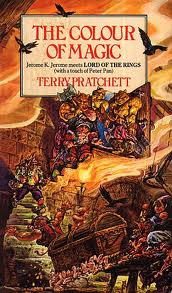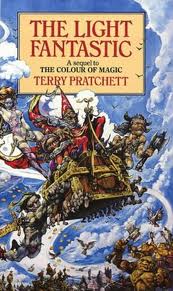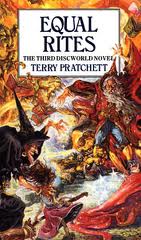
I first encountered the Discworld in the early 90's, sometime around the period between Men At Arms and Soul Music, thanks to the wonders of Kidderminster library. The series was coming up to it's tenth anniversary at this point and the most recent books on the shelves showed an author pretty much at his peak (it's staggering to think that for most of the late 80's and a large chunk of the 90's he was doing two books a year with no decline in quality) and I very quickly became hooked. The comics and audio tapes helped expose me to the early books as well, and by the time I left school in 1998 I was pretty much on top of having my own copies of all the books up till that point. From The Last Continent that same year I even started buying them in hardback as they came out rather than waiting for the paperbacks, which was a fairly steep increase in what I was paying for an unemployed school kid.
The Colour of Magic/The Light Fantastic: Pretty much one long book really (which, thanks to the TV version treating that way is how you can buy it now via the tie in edition), that's of most interest these days as an example of Pratchett developing his writing style slowly over the course of these early novels.
Magic has a lot of nice ideas in it and I've always liked Rincewind, but the piecemeal structure of the book means it doesn't really hold together, and the four sections don't really flow into each other very well (most obvious from the way Twoflower's inability to speak English is dropped after the opening without explanation). There's also a strange jump between the third and fourth sections, as if Pratchett suddenly realised he was up against the word count and didn't have space to show Rincewind's adventures on the slaver ship as anything more that hearsay after the fact.
Light Fantastic at least has a proper plot, and the comedy is generally a lot sharper and the commentary on the Star worshippers is really his first haltering step towards more serious and thoughtful novels. Cohen is basically a one gag character ("What if Conan were like, really old?") but is still a lot of fun and the climax atop the Tower of Art is suitably epic.

Several of the recurring characters don't feel quite right either, Death is extremely callous in his desire to see Rincewind die, and the Librarian (and I'd actually forgotten we get an origin for him rather than him being an Orang-utan from the off), who'll wind up as the most level headed and sensible of the Unseen University's staff despite only being able to say “OOOK”, is much more a silly ape who has his loyalties brought by a banana.
Equal Rites: The first of the Witch books, and generally regarded by many as the first "Real" Discworld novel due to the opening two books having a very different feel compared to what would become standard.
Now, I must admit to being virtually alone amongst Discworld readers in being left somewhat cold by the witch books, they never really manage to connect with me terribly well.
However, having not read this book in about ten years (or more strictly, listened to the Tony Robinson read abridged audiobook) I was surprised how little I remembered, and indeed how much I wound up enjoying it.
It's still very much early days though, Granny Weatherwax is a lot less world wise than she'd become (it's hard to imagine even the version from her second appearance in the sixth book being so clueless about city life) and Pratchett struggles to make the plot fit the length, for a novel about a girl going to learn to be a wizard it takes the best part of 200 pages for Esk to even arrive at Unseen University.
However, with a young heroin we get what would become a Pratchett staple (the naive youngster going into the world to find their place in a most unusual way), and though it will be a good 7 books before the University staff settles down the interaction of the Wizards here is very much in line with what will become the norm for the series.
The send up of sexist attitudes isn't exactly subtle (and the idea of it being impossible to have female wizards feels somewhat odd when there was one in The Colour of Magic, but then as the reuse of the name Weatherwax for a major character two books in a row shows Pratchett wasn't so bothered by inter-novel continuity at this point), but Esk's struggles against the attitudes of everyone who tells her it's impossible for her to fulfil the destiny handed to her at birth is surprisingly affecting and very well done.

If there's one shame about the book as a whole it's in relation to its place in the series. Once she manages to get accepted as the first female Wizard we promptly don't see Esk again for 23 years, until her rather pleasing cameo in I Shall Wear Midnight. Considering the events of books like Sourcery it was entirely possible for her to have met a horrible end off page, so the confirmation she was both still alive and a full Wizard was very welcome, even if the description of her as an old woman with white hair does make you wonder about the time scale (and how old Weatherwax must be by now).
Despite Equal Rites being a considerable improvement in the Rincewind duo in terms of style, these first three books are still very much a journey in Pratchett finding his feat. The next book will not only be the first to focus entirely on Death, but even all these years later remains one of the very best in the series. It might have started off on a rocky road, but by the time Esk enters Unseen University the Discworld as we recognise it today had arrived.
 RSS Feed
RSS Feed
